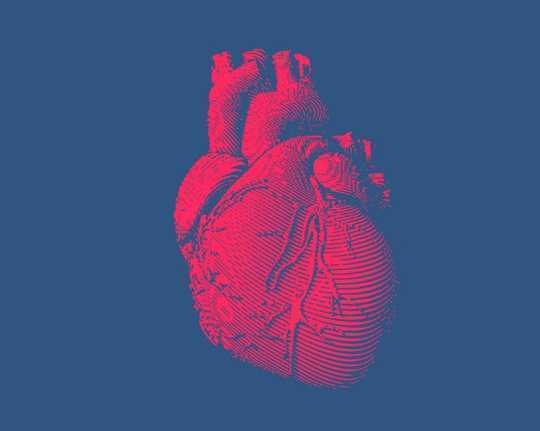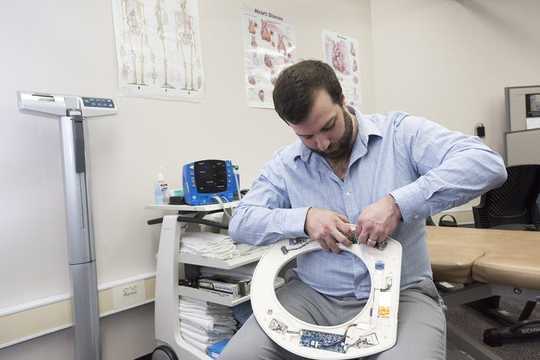
An engraving of a heart. www.shutterstock.com
America is aging rapidly. In the next 40 years, the number of people age 65 and older is expected to nearly double. Of these older Americans, more than 80% will have some form of heart disease.
As medical advances prolong life and help people survive heart attacks, more people end up living with congestive heart failure. This is a chronic disease where the heart muscle is weakened and cannot meet the needs of the body. It affects more than 6.5 million adults in the U.S. and is estimated to cost the country $35 billion in health care costs each year. For congestive heart failure patients, nearly 80% of these health care costs result from hospitalization. The personal costs are high, too. Nearly half of those who develop and are diagnosed with congestive heart failure will die within five years.
When these patients are hospitalized and then discharged, nearly half end up back in the hospital within 90 days. One reason is because intermittent visits to health care professionals may miss signs of deteriorating conditions. Another reason is that patients do not always take medications as prescribed nor monitor themselves. Despite physician recommendations, fewer than 10% of congestive heart failure patients monitor themselves for symptoms of deterioration.
I’m a researcher at the Rochester Institute of Technology and founder of a medical device startup. In 2014, when I was working toward my Ph.D., my adviser, David Borkholder, and I were trying to solve the problem of how patients could more simply and easily monitor their heart health at home without learning a new habit. Could sensors be integrated into a steering wheel? Or a computer mouse? Neither was something that would be used daily by people with advanced cardiovascular disease. Instead, we came up with another device that is used far more frequently and by virtually everyone: a toilet seat.
Get The Latest By Email
How patients are monitored today
To monitor congestive heart failure at home, doctors and patients still rely heavily on blood pressure cuffs, body weight scales and portable electrocardiogram monitors. But recent studies indicate that these widely used devices do not appear to reduce hospital readmissions – even when patients are coached remotely over the phone. This is because they just don’t use them consistently enough. According to one study’s investigator, “There remain difficulties in getting heart failure patients even to perform basic aspects of self-care, such as daily weight and BP monitoring.”
A newer technology, the only device with FDA approval for reducing congestive heart failure hospitalizations, is CardioMEMS, an implant that tracks pulmonary artery pressures and relays that information remotely to a medical team. In clinical trials, CardioMEMS demonstrated a 37% reduction in total congestive heart failure hospitalizations. Recent publications indicate that the reduction in hospitalizations can be as high as 46% with an average cost savings of $13,190 per patient within the first year post-implantation.
There are high expectations for current and future technologies such as wearable devices that record physical activity, heart rate and other data. But these devices can be impractical, adding a significant burden to patients with heart disease by requiring that wearers actively acquire data, regularly wear the sensors and keep them charged. This can lead to high abandonment rates.
What if heart monitoring were effortless?

An everyday toilet seat built to capture vital medical data. Photo by A. Sue Weisler/RIT, Author provided
In 2014, when Borkholder and I first imagined a toilet seat that would monitor heart health, I immediately tested the concept on myself and hooked electrodes to my gluteus maximus to see if this crazy concept had promise. After a few weeks of testing, a proof of concept device emerged that was built on top of a toilet seat from the local hardware store.
During the next four years, the two of us along with Karl Schwarz from the University of Rochester Medical Center, solved many of the fundamental challenges of this type of monitoring. Unlike sensors that are used in a hospital or existing in-home monitoring devices, the toilet seat captures data from nonstandard locations – such as measuring blood oxygenation on the back of the thigh, rather than the finger. We developed custom circuitry and algorithms to work with this data, including one that accurately identifies heart beats in noisy data.
The seat is installed on a standard toilet. Users are not required to do anything other than sit down, a habit they already have and one that can practically ensure daily measurements. We’ve published two peer-reviewed journal papers in 2018 and 2019 and tested the technology on over 300 human subjects to validate the measurements. Currently, this technology is being commercialized with plans in place to seek FDA approval in 2021.
Today, many new medical devices are being created to help people live longer, more productive lives. These technological advances have the potential to shift from a reactive approach to health care, to one that is preventative and proactive, while simultaneously lowering the cost of care and improving the quality of life.
About the Author
Nicholas Conn, Research Scientist, Microsystems Engineering, Rochester Institute of Technology
This article is republished from The Conversation under a Creative Commons license. Read the original article.
books_health







